They’re a tradition almost everywhere in the central valley of Oaxaca. Grabbing one on the way home from work. Maybe eating it standing up. Most often eating it with your hands. Calle Libres, one of the main drags in the state capital, is lined with restaurants that all have a slightly different take on them. But outside of Oaxaca, they’re as rare as rocking horse doodoo, unless your town has an Oaxacan restaurant. And San Miguel de Allende has one, a very good one.
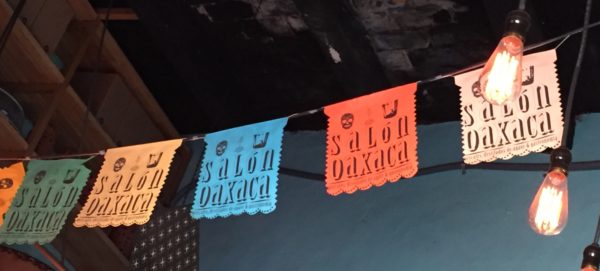
I’m talking about tlayudas, what I consider the iconic Oaxacan dish. And the restaurant with the straight-to-the-point name of Salón Oaxaca that, despite being around for a couple of years, remains an unknown to most San Miguelenses.
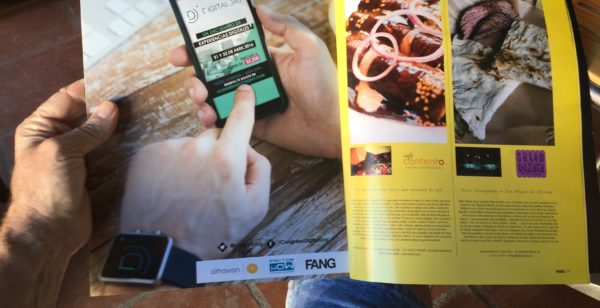
A couple of Don Day’s advance scouts had emailed me about Salón Oaxaca and I’d seen the restaurant’s ad in the pages of the very well designed Fang published out of Guanajuato. The magazine is aimed at the hipster crowd, the guys with tight t-shirts, skinny-leg jeans, two too many tattoos and three days growth of beard and you’ll see them in Salón Oaxaca sitting at the bar chasing a shot of Mezcal with a double shot of espresso. You’ll see copies of Fang sitting on the bar next to them.

In addition to those bar stools, there’s seating for about ten in the slightly better than a hole-in-a-wall main room, space for another ten or so in the courtyard, and seating for about 40 more on a rooftop patio that, in the evening, when the sun has sunk behind the Sierras, is one of the very best places in town to sip a mezcal and wash it down with a beer or two.
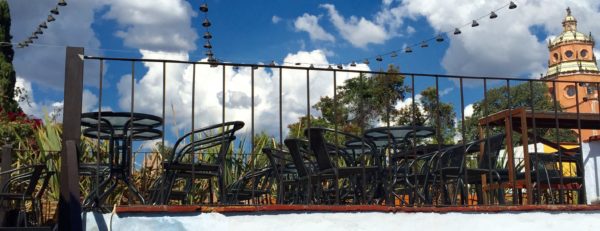
And those tlayudas. There are four on the menu, including one very traditional one appropriately called Tlayuda Clásica. But first, seeing that I, a food fanatic, only discovered tyaludas a couple of years ago, I better describe what they are.
If you’re familiar with the very trendy Neopolitan-style pizzas with the puffy and blistered, ultra-thin crust, you’re in the right ballpark. The crust of a tlayuda is actually a giant tortilla that has been slightly overcooked and partially dried on a comal or griddle. They traditionally vary in size from 10 to 16 inches in diameter and the crusts at Salón Oaxaca are about average, at 14 inches (the world record, just in case you’re interested, was 10 feet across and weighed 285 pounds).
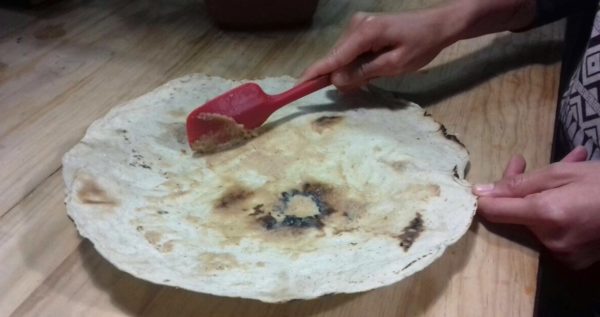
The crust is first smeared with a mixture of lard and deep fried pork skin (you’re probably starting to understand why Don Day likes them so much). Next comes a thin layer of black beans. Then there are strands of torn up Quesilla, the Oaxacan cheese, but not enough to make it as cheesy as a pizza. Next come vegetables which might include cabbage or avocado and, in the case of Salón Oaxaca’s Tlayuda Clásica, raw onions and lettuce. You could stop right there and you’d have a tlayuda. But Salón Oaxaca doesn’t. On their Tlayuda Clásica there is also the choice of two meats, tasajo or cecina, both of which probably require some explanation.
Throughout most of Mexico, cecina refers to air-dried and salted strips of beef, usually top or bottom round, that is similar in taste to jerky. In Oaxaca, however, and also on Salón Oaxaca’s menu, this is called tasajo.
The cecina on Salón Oaxaca’s menu is different. This is cecina enchilada, strips of salted pork that are marinated, adobo style, in achiote (a natural coloring ingredient) and ground chiles.
I asked Mario Iribe-Benítez, the owner, which of the two meats he recommended.
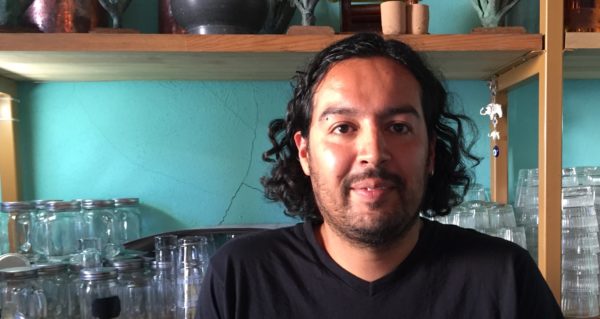
“Definitely the cecina”, he replied. “We do that here in-house.”
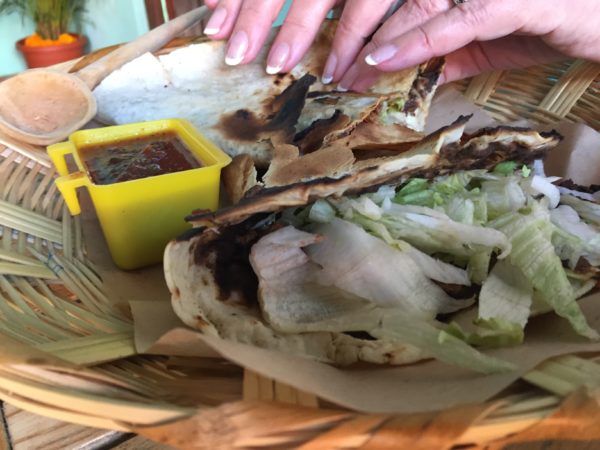
The Tlayuda Clásica comes to the table folded in half, the way they’re usually but not always served in Oaxaca. The tortilla is slightly charred, crispy and crunchy, but still with enough give that it doesn’t quite fall apart. And the filling? After you add the spicy house salsa, you have a giant taco with a giant-sized amount of taste.
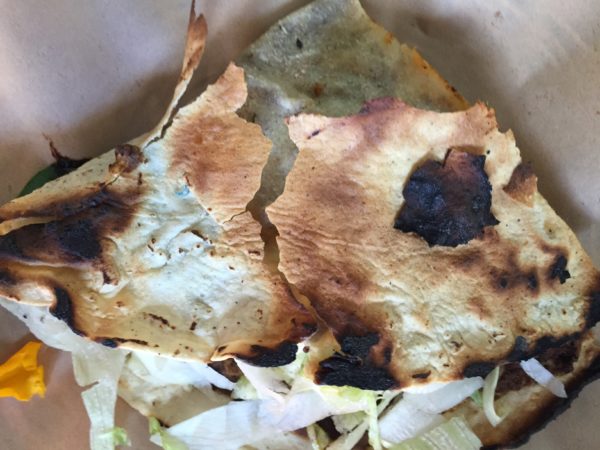
Now I hate asking the next question but I always have to. I have to know the source of the recipe. The problem is I almost always get the same answer, something about how it was passed from their bisabuela, their great-grandmother, down through the family. Well my mother spent her entire life in the restaurant biz and I can’t remember her passing a single recipe down to me.
When I asked Mario where his recipes came from he did mention his family but then he went into the kitchen and brought out the source that he gave most of the credit to, a dog-eared copy of Oaxaca Al Gusto by Diana Kennedy.
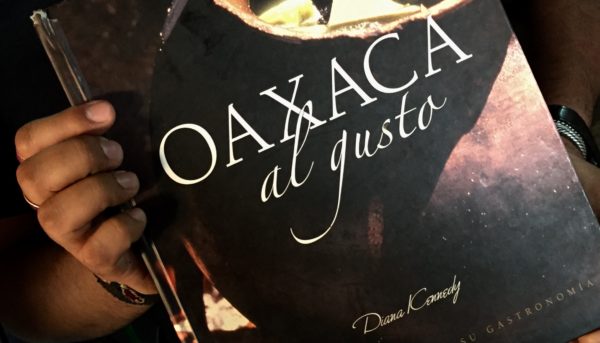
“We add a little here, take a little away here, tweak this, tweak that, but this is our bible”, said Mario.
The “we” that Mario refers to are chef Lupita Chávez Martínez and bartender Oscar Trejo Ortíz.
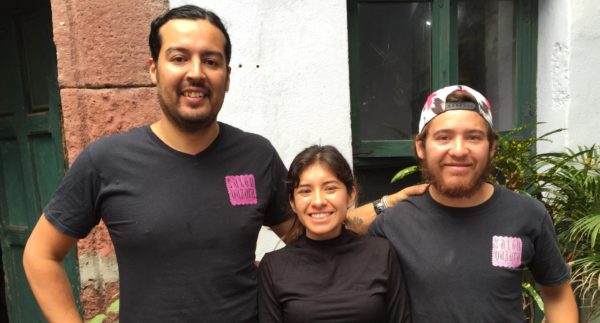
”We all work in the kitchen. We have designed the recipes and the menu as a team. My wife and I have taught Lupita and Oscar about Oaxacan cuisine because they weren’t very familiar with it. They really believe in the project and they have learned everything”, Mario continued.
In Oaxaca, many restaurants add different ingredients to their tlayudas simply for the sake of being different. Salón Oaxaca sticks to their knitting. The other three tlayudas on their menu are Tlayuda Botanera, a basic one that is served unfolded and without any meat; a vegetarian version called Tlayuda María Sabina that substitutes the pork crackling and lard with assorted seeds in olive oil then adds beans, cheese, lettuce and garlic mushrooms; and Oaxaqueña, another traditional tlayuda that I will never eat because it includes chapulines, the nasty little high jumpers that devoured my basil plants last summer.
The menu is very short and I very much like short menus. There are no appetizers, no soups or salads, no desserts at Salón Oaxaca. And I’ve discovered that, most of the time, restaurants with short menus end up having long histories.
In addition to the four tlayudas, there are just four other mains.
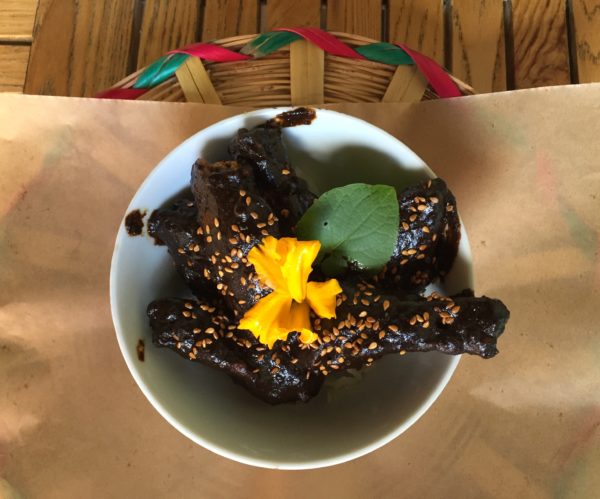
Very moist chicken wings are bathed in one of Oaxaca’s seven classic sauces, mole negra, which Don Day likes because “it tastes really chocolatey” and Don Day’s Wife dislikes because “it tastes really chocolatey”.

Don Day also doesn’t mind that the sauce is still under and around his nails the next morning. One guess what his wife thinks.

The mole negra is homemade (hard to believe, but a lot of restaurants buy their sauces) as is the mole amarillo that was soon to be served with the pork belly that Oscar was trimming.
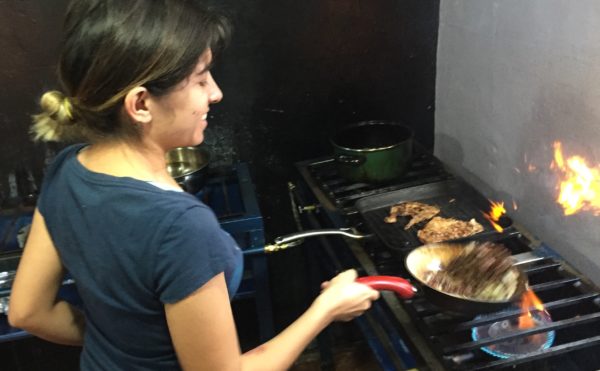
For the Tacos de Sirloin al Chintextle, chef Lupita sautés the beef in the restaurant’s privately bottled Mezcal Insurrecto and then serves it with a smoky Oaxacan sauce made from dried shrimp and pasilla chiles.
San Miguel de Allende has always had restaurants with Oaxacan dishes on their menu, including tlayudas, but Salón Oaxaca is the first in recent years to be totally dedicated to the regional cuisine that, I think, has done more than any other area in the country to put Mexico on the world food map.

Here’s to raising a glass of Mezcal to never too many tlayudas. Here’s to letting the secret out about Salón Oaxaca.
Salón Oaxaca is located at Insurgentes 44 in San Miguel de Allende, Mexico. They are open from 1:30 to 11:00 pm every day but Tuesday. Telephone 415 125 9571.


I will be eating my lunch there. Gracias once again Don.
I found this address. Definitely a must try when we arrive in January.
Insurgentes 46, Centro, Zona Centro,
I believe they are called tlayudas. Salsabor on Orizaba in SMA serves a delicious version.
This is wonderful news,Don. I spent 5 weeks in Oaxaca several years ago and don’t recll seeing them, as you describe them, though the version I’ve had, with Mexican friends in Toluca and Metapec, was completely different, stuffed with 2 fillings of choice me with masa azul (tortilla dough).
Th food in Oaxaca was muy rico.
DD… glad you are promoting Salon Oaxaca. Eating there one can tell it is a labor of love. And, yes, a great roof … air, light, crispy bits and mezcal.
Well, the genius chef Mario Iribe is back at it again! He’s teamed up to create Venencia Restaurant on Zacerateros 81b. In addition to authentic Oaxacan small plates, they are also doing Mezcal Tastings, Wine Tastings and much, much more. The goal is for everything, food, wine and spirits to be Mexican. This is a natural progression for Mario’s talent